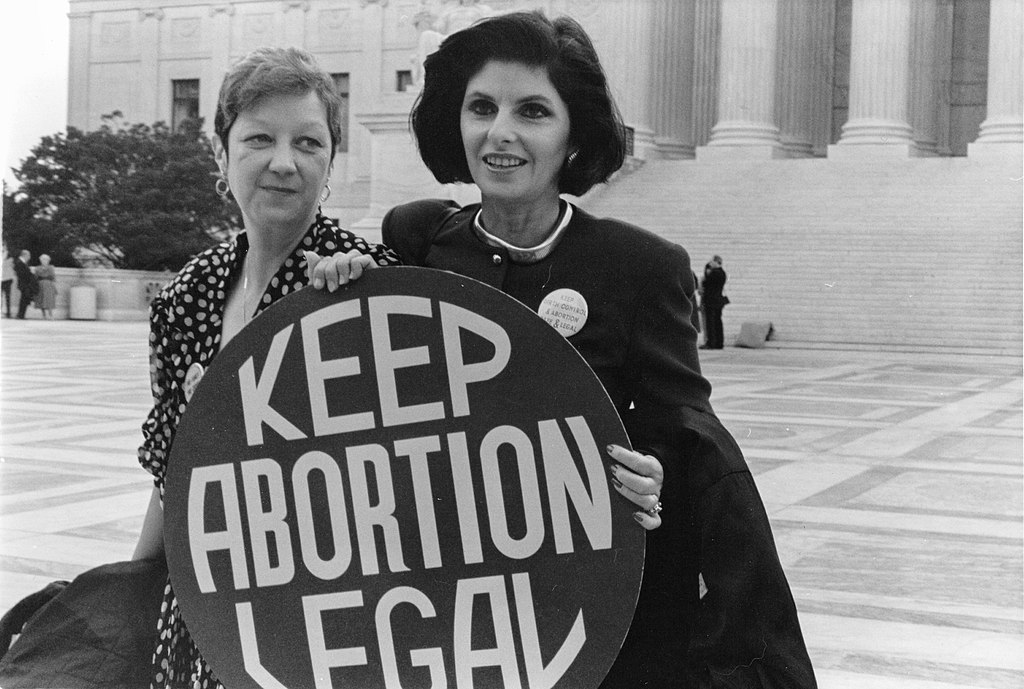For those of us who study the history of reproduction, the leak in early May of the Supreme Court’s draft opinion in Dobbs v. Jackson Women’s Health Organization was disturbing but not necessarily surprising.[1] Written by Justice Alito, the language referring to the “domestic supply of babies” and his use of 13th century English case law looked eerily like some of the historical sources we examine. And like our historical sources, his words will have consequences for women’s health and beyond. The draft text – if it remains – sets the stage not just for overturning the legal right to abortion, but perhaps even for other “settled law” that could now be perceived by an emboldened Court as not “deeply rooted” in American history and tradition. At stake is the meaning of the 14th amendment, and interpretations of its due process and equal protection clauses. As other scholars have noted elsewhere, this could include everything from the right to same-sex marriage (Obergefell) to legal to contraception (Griswold), and even desegregation (Brown).[2]

A closer examination of the historical context surrounding Roe sheds some light on why the decision, even in 1973, was already vulnerable to a future interpretation like Alito’s. This is not to say, despite accusations to the contrary, that Roe is the source of America’s political fracturing, nor was it the central issue that divided Republicans and Democrats in the late twentieth century.[3] The summer before Roe was handed down, a 1972 Gallup poll recorded that 68% of Republicans as compared to 59% of Democrats supported the statement that “abortion should be a matter for decision solely between a woman and her physician.”[4] This was no surprise, however. Republicans in Congress like George H.W. Bush had just recently sponsored bipartisan bills like Title X of the Public Health Act which provided for federally funded family planning services, and then signed into law by Republican president Richard Nixon.[5]
Nonetheless, when Norma McCorvey (Jane Roe) first sought to challenge Texas abortion law in 1969, women’s legal status in the United States was at best undefined and there had been only modest legal progress for women’s rights past the Nineteenth Amendment.[6] Birth control was still only legal for married couples, and single women seeking contraceptive prescriptions or abortions were subject not just to their state’s laws but to the patriarchal whims of medical paternalism.[7] Even as the feminist movement gained traction in the 1960s, women’s rights within marriage, at work, and in the broader polity remained radically incomplete. It is this context that informed the rationales of the nine men who made up the Court in 1973 and their decision about American women’s right to an abortion.
The majority opinion in Roe drew in part on an earlier case, Griswold v. Connecticut (1965), which ruled for a constitutional right to marital privacy and the right to of couples to use birth control. Building on this, the Justices concluded that the Fourteenth Amendment also conferred the right to privacy for women seeking an abortion. The Court then decreed this right was not unqualified and specified that restrictions could legally exist in the second and third trimester. Access to abortion in the aftermath of Roe thus remained somewhat uneven and stratified along racial and class lines. But in general, public memory recalls Roe as the legal source of women’s bodily autonomy.
A closer reading of Justice Blackmun’s majority opinion in Roe reveals a different emphasis, one little remembered today in the common perception of the case’s meaning for abortion rights. He wrote in the summary conclusion, “The decision vindicates the right of the physician to administer medical treatment according to his professional judgment up to the points where important state interests provide compelling justifications for intervention. Up to those points, the abortion decision in all its aspects is inherently, and primarily, a medical decision, and basic responsibility for it must rest with the physician.” The word “autonomy” never appears. In fact, Blackmun specifically rejected a feminist framework for abortion, noting “…appellant and some amici argue that the woman’s right is absolute and that she is entitled to terminate her pregnancy at whatever time, in whatever way, and for whatever reason she alone chooses. With this we do not agree.”[8]
Blackmun’s refusal to entertain feminist rationales for abortion and his understanding of the meaning of privacy mirrored the larger context of gender roles in twentieth-century America. In 1973, ideas about marital privacy and women’s reproductive rights might have cursorily referenced feminism, but more often were still wrapped in a patriarchal cultural valence. Marital privacy for most of American history meant the right of a husband who might or might not, depending on his caprices or temperament, allow his wife to make decisions on her own about her use of contraception, her health, her body, or her financial and employment matters.
In the era of Roe and Griswold, the idea that birth control or abortion belonged to the private sphere as part of a woman’s decision, was not inherent – in fact, it was only these cases that would forge that link more explicitly in the coming decades.[9]Rather, the law recognized abortion and birth control not as a woman’s right but as the domain of American medicine. Blackmun’s parting words in the opinion emphasized “professional judgement” and the physicians’ responsibility for managing abortions. He was, of course, drawing on a long tradition. As physicians grew increasingly professionalized in the latter half of the 19th century, obstetricians and gynecologists who specialized in “the diseases of women” gained particular social stature.[10] By 1936, the birth control movement’s fight was largely over for these physicians because of United States v. One Package of Japanese Pessaries, in which the Second Circuit decided that physicians’ professional rights embraced the right to prescribe contraceptive devices for medical reasons. The decision contributed to an increase in the establishment of birth control clinics across the United States beginning in the early 1940s, and expanded access to contraceptives for some patients. But, in general, birth control remained largely governed by doctors’ moral opinions of who should be using it. The birth control movement had thus, like other matters of women’s health, became yet another catalyst in expanding and solidifying racist and paternalist decision-making in American medicine, with doctors insisting it was their obligation to either provide or deny treatments based on their sole judgements of what the patient did or didn’t need.[11] By the time Blackmun authored his opinion in Roe, doctors had been freed for nearly 40 years to preside over the health and morality of their patients, cultivating their role as the self-appointed arbiters of marital and family health. Despite this, Roe’s social impact utterly transformed feminism and women’s status in the following decades. On its heels came other cases that expanded women’s rights across the board in marriage, labor, education, property, financial, and welfare rights. Today, the possibility of overturning of Roe v. Wade threatens to undo the fragile nature of female citizenship and imperils American democracy itself. The rights to abortion, birth control, same-sex marriage and other fundamental rights that have so far relied on expansive readings of the 14th amendment must instead be codified in other ways throughout every level of government and made more explicit in the Constitution via an Equal Rights Amendment. A historical reading of Roe tells us that merely upholding it is, quite simply, not enough.
[1] SCOTUS Initial Draft, Contributed by Politico Staff, February 10, 2022, https://www.documentcloud.org/documents/21835435-scotus-initial-draft
[2] “Could overturning Roe v. Wade have implications beyond abortion?” NPR. https://www.npr.org/2022/05/05/1096732347/roe-v-wade-implications-beyond-abortion. Accessed May 5, 2022. Obergefell v. Hodges 576 U.S. _ (2015); Griswold v. Connecticut 381 U.S. 479 (1965); Brown v. Board of Education 347 U.S. 483 (1954).
[3] “Where Roe went wrong: A sweeping new abortion right built on a shaky legal foundation.” Accessed May 5, 2022. https://www.latimes.com/politics/story/2022-05-03/how-roe-vs-wade-went-wrong-broad-new-right-to-abortion-rested-on-a-shaky-legal-foundation
[4] Linda Greenhouse and Reva B. Siegel, “Before (and After) Roe v. Wade: New Questions About Backlash, “ 120 Yale Law Journal 2071-76 (2011),
[5] Kinsey Hasstedt, “Why We Cannot Afford to Undercut the Title X National Family Planning Program,” 20 Guttmacher Policy Review (May 2017). https://www.guttmacher.org/gpr/2017/01/why-we-cannot-afford-undercut-title-x-national-family-planning-program. Accessed June 7, 2022
[6] Sara Evans, Personal Politics: The Roots of Women’s Liberation in the Civil Rights Movement & the New Left (New York: Knopf, 1979); Alison Lefkovitz, Strange Bedfellows: Marriage in the Age of Women’s Liberation (Philadelphia: University of Pennsylvania Press, 2018); Elaine Tyler May, Homeward Bound: American Families in the Cold War Era (New York: Basic Books, 1988); Serena Mayeri, Reasoning from Race: Feminism, Law, and the Civil Rights Revolution (Cambridge: Harvard University Press, 2011); Joanne Meyerowitz, ed., Not June Cleaver: Women and Gender in Postwar America, 1945-1960 (Philadelphia: Temple University Press, 1994); Leslie J. Reagan, When Abortion Was a Crime: Women, Medicine, and Law in the United States, 1867-1973 (Berkley: University of California Press, 1997);
[7] Cathy Moran Hajo, Birth Control on Main Street: Organizing Clinics in the United States, 1916-1939 (Urbana: University of Illinois Press, 2010).
[8] Roe v. Wade, 410 US 113 (1973); pp. 166; 153.
[9]Sarah Igo, The Known Citizen: A History of Privacy in Modern America (Cambridge: Harvard University Press, 2018), 149-150.
[10] Franz Winckel, Joseph H. Williamson, Theophilus Parvin, Diseases of Women: A Handbook for Physicians and Students(United Kingdom: Young J. Pentland, 1887).
[11] Leslie J. Reagan, “”About to Meet Her Maker”: Women, Doctors, Dying Declarations, and the State’s Investigation of Abortion, Chicago, 1867-1940.” The Journal of American History 77, no. 4 (1991): 1240-1264; Kara W. Swanson, “The Doctor’s Dilemma: Paternalisms in the Medicolegal History of Assisted Reproduction and Abortion,” The Journal of Law, Medicine & Ethics, 43(2), 312–325; Lauren MacIvor Thompson, “The Politics of Female Pain: Women’s Citizenship, Twilight Sleep, and the Early Birth Control Movement,” 45 Medical Humanities (2019): 67-74.


 Thompson’s current research focuses on the intersections of medical authority and expertise, women’s health, and public health policy in the birth control and reproductive health movements. She is working on a book manuscript, Rivals and Rights: Mary Dennett, Margaret Sanger, and the Making of the American Birth Control Movement, forthcoming with Rutgers University Press. She has published numerous articles and op-eds including work in Law and History Review, The Journal of the Gilded Age and Progressive Era, the Washington Post and the New York Times.
Thompson’s current research focuses on the intersections of medical authority and expertise, women’s health, and public health policy in the birth control and reproductive health movements. She is working on a book manuscript, Rivals and Rights: Mary Dennett, Margaret Sanger, and the Making of the American Birth Control Movement, forthcoming with Rutgers University Press. She has published numerous articles and op-eds including work in Law and History Review, The Journal of the Gilded Age and Progressive Era, the Washington Post and the New York Times.